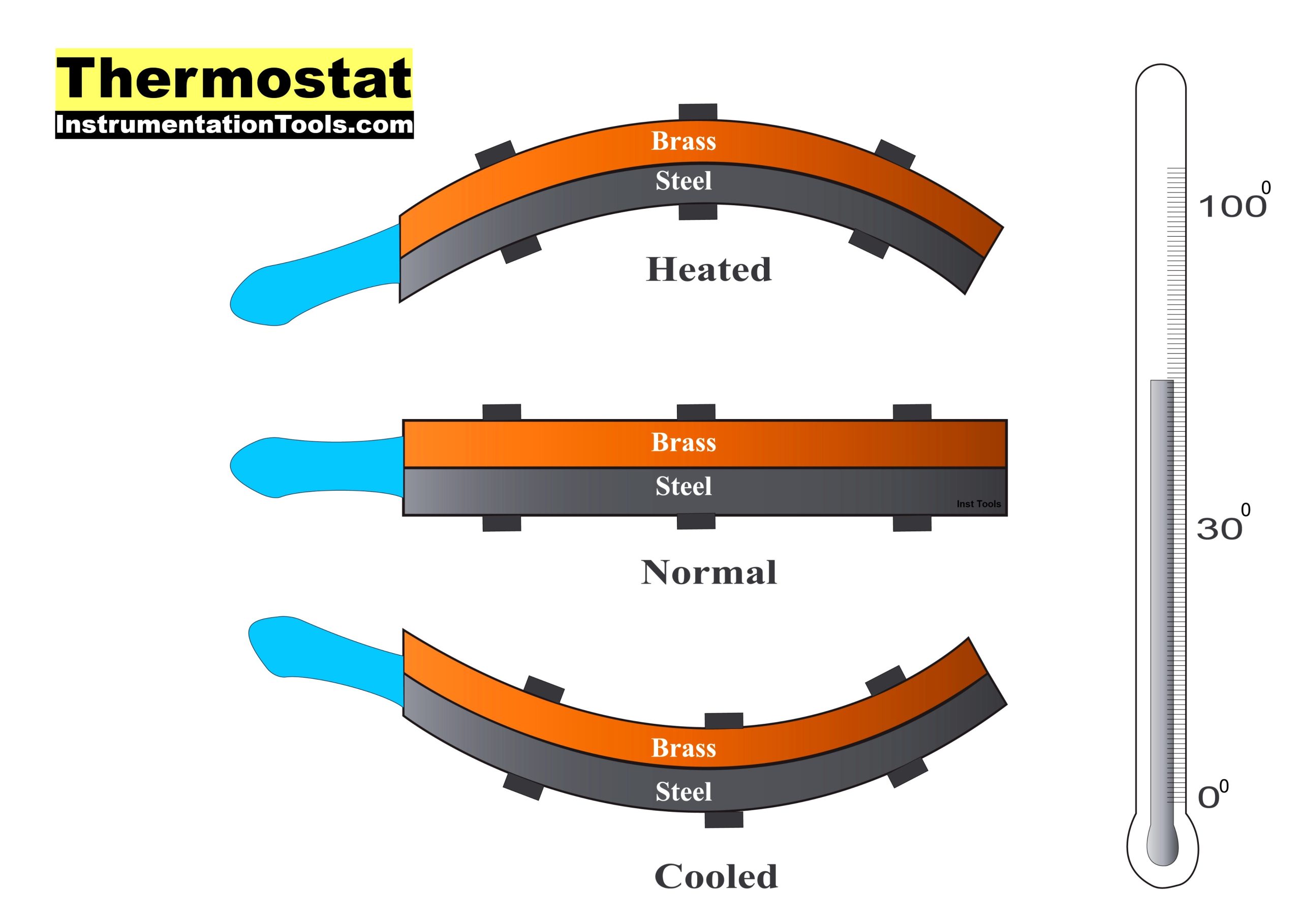What is a Thermostat?
A thermostat is a handy device that controls the temperature in various household items like refrigerators, air conditioners, and irons. It’s like a temperature watchdog, keeping an eye on how hot or cold things are and adjusting them to just the right level.
How Does a Thermostat Work?
The secret behind a thermostat is the idea of “thermal expansion.” Imagine a solid bar of metal getting longer as it gets hotter. That’s thermal expansion.
Bimetallic Strips Thermostat

Now, think of sticking two different kinds of metal together into one strip. This double-metal strip is the brain of a traditional thermostat.
- When It’s Cold: The double-metal strip stays straight, and electricity flows through it, turning the heater on. You can picture this like a bridge that’s down, letting cars (electricity) through.
- When It Gets Hot: One metal gets longer faster than the other, so the strip bends. If it bends enough, it’s like the bridge going up. The cars (electricity) can’t get through anymore, so the heater turns off, and the room cools down.
- Cooling Down: As the room gets colder, the strip goes back to being straight. The bridge is down again, and the heater turns back on.
By twisting a temperature dial, you tell the thermostat the exact point you want the bridge to go up or down. It won’t happen instantly; the metal needs time to bend. This slow bending ensures the heater doesn’t keep turning on and off all the time.
The Science of Bimetallic Thermostat
Here’s how this clever double-metal strip (bimetallic strip) works in detail:
- Setting the Temperature: A dial lets you pick the temperature at which the heater turns on or off.
- Bimetal Strip: The strip is made of two metals (like iron and brass) bolted together. Iron doesn’t get as long as brass when it’s heated, so the strip bends inward when hot.
- Electrical Circuit: The bimetal strip is part of an electrical path (shown in gray). When the strip is cool and straight, it’s like a bridge, and the heater is on. When it bends, the bridge is broken, and the heater is off.
Types of Thermostats
- Mechanical Thermostats
- Bimetallic Strip Thermostats
- Liquid-Filled Thermostats
- Electronic Thermostats
- Digital Thermostats
- Programmable Thermostats
- Smart Thermostats
- Hybrid Thermostats
- Line Voltage Thermostats
- Low Voltage Thermostats
- Pneumatic Thermostats
Advantages
- Precise temperature control
- Energy efficiency
- Convenience and easy adjustment
- Integration with other systems
- Enhanced functionality such as learning behavior and maintenance alerts
Disadvantages
- Complexity and higher cost
- Compatibility issues with heating and cooling systems
- Dependence on power (electricity)
- Potential for inaccurate readings
- Maintenance and possible battery replacements
Applications
- Residential heating and cooling systems
- Commercial building climate control
- Automotive cooling systems
- Industrial temperature regulation
- Refrigeration systems
- Greenhouses
- Aquarium temperature control
- Medical equipment temperature regulation
- Cooking appliances like ovens and grills
- Water heating systems
Conclusion
A thermostat, with its bimetallic strip, is like a smart bridge controller, always knowing when to let electricity through (heater on) or stop it (heater off). By understanding and responding to temperature, this simple device helps keep our homes comfy and our energy bills in check. It’s a beautiful example of how something small and smart can make a big difference in our daily lives.
nice post ……
I have one doubt…
how the material properties are getting changed based on the input temperature in dial switch in thermostat working principle…..
eg.
if i set a temp 30 deg C …. the bimetal bends at 30 deg C
if i set temp 100 deg C ….the bimetal bends at 100 deg C
how this happens ???
How the bimaterial Property changes with set point .
Changing thermostat value actually changes the position of wire 2 relative to bimettalic strip.
if you increase value for example in above case, it will move the touching end of wire 2 with bimetallic strip furthur to right causing the touching end stay for long time with bimettalic strip.
Really super post
is there stripe heated by resistance of heat or the heat of heater.
*resistance of stripe or heat from heater